Organisational Behaviour: Impact on Workplace Performance and Issues
VerifiedAdded on 2020/02/24
|8
|2127
|102
Essay
AI Summary
This essay provides a comprehensive overview of organisational behaviour and its critical role in the workplace. It begins by defining organisational behaviour and emphasizing its significance in understanding how individuals interact to achieve mutual goals. The essay delves into key theories such as Scientific Management, Bureaucratic Theory, and Contingency Theory, highlighting their contributions to managing and improving organizational efficiency. Furthermore, it examines various models of organisational behaviour, including autocratic, custodial, supportive, and collegial approaches. The impact of attitudes, job satisfaction, and organisational commitment on employee behaviour and performance is thoroughly discussed. The essay also addresses contemporary issues in organisational behaviour, such as social, ethical, and cultural concerns, and explores strategies for effective management and employee engagement. The conclusion underscores the importance of adapting organisational behaviour to foster a positive and productive work environment.
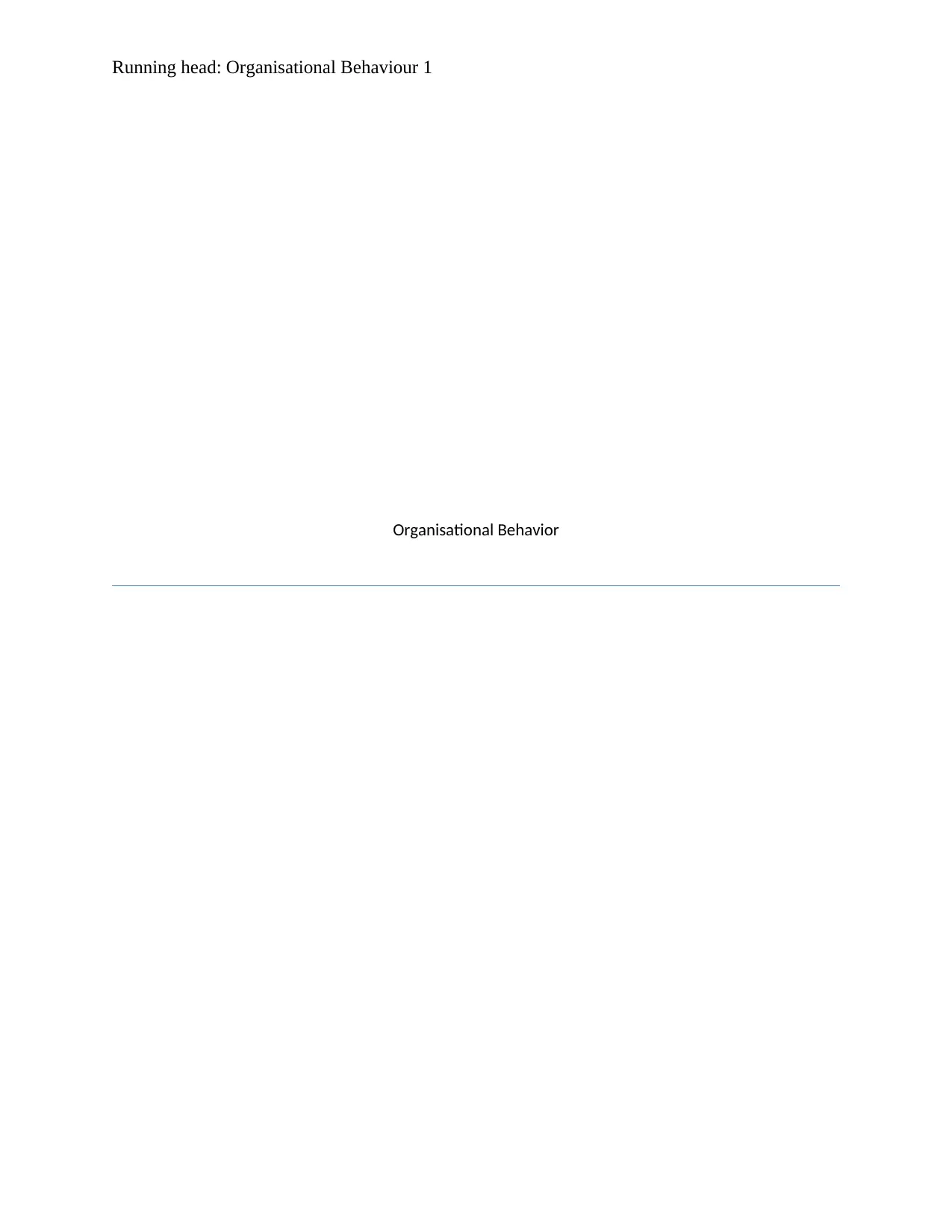
Running head: Organisational Behaviour 1
Organisational Behavior
Organisational Behavior
Paraphrase This Document
Need a fresh take? Get an instant paraphrase of this document with our AI Paraphraser
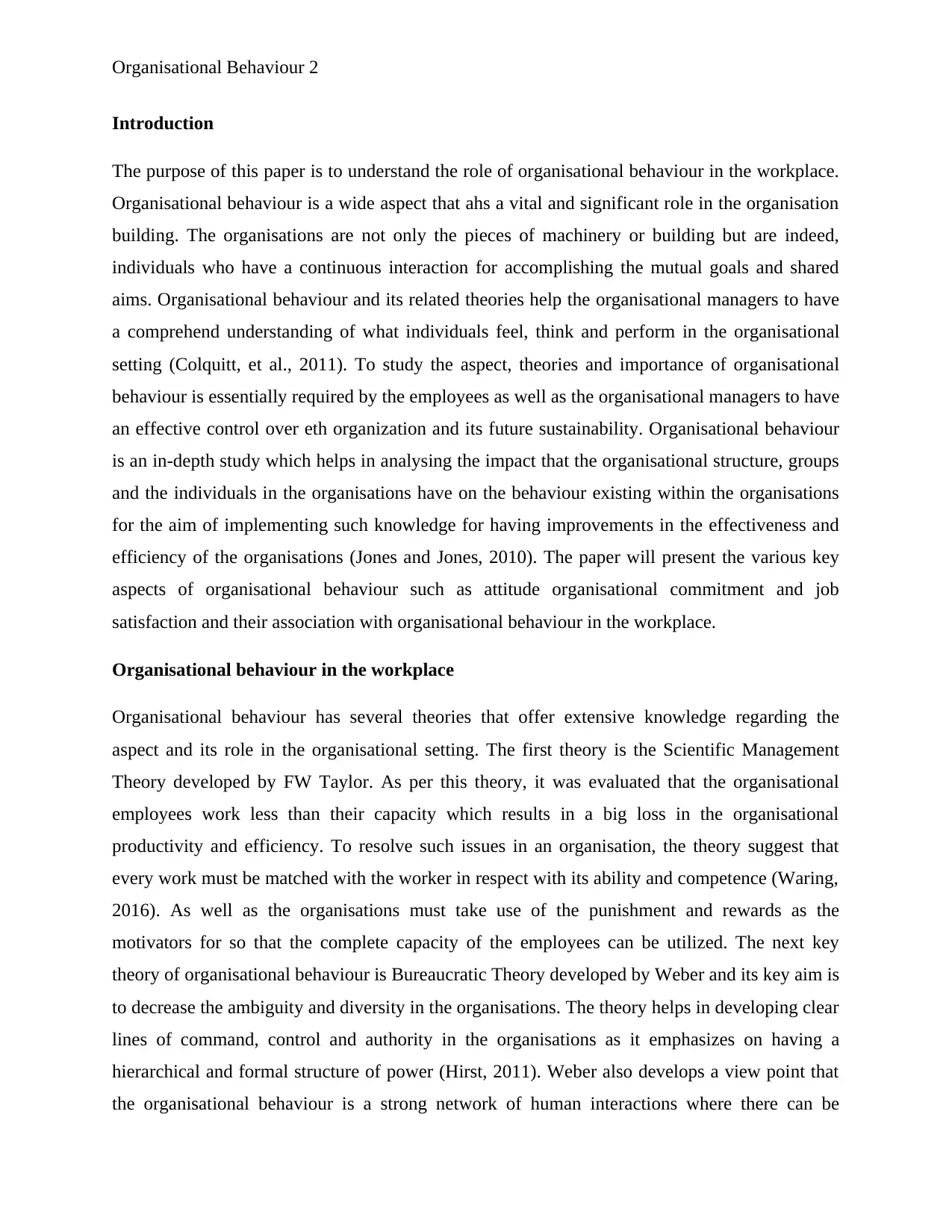
Organisational Behaviour 2
Introduction
The purpose of this paper is to understand the role of organisational behaviour in the workplace.
Organisational behaviour is a wide aspect that ahs a vital and significant role in the organisation
building. The organisations are not only the pieces of machinery or building but are indeed,
individuals who have a continuous interaction for accomplishing the mutual goals and shared
aims. Organisational behaviour and its related theories help the organisational managers to have
a comprehend understanding of what individuals feel, think and perform in the organisational
setting (Colquitt, et al., 2011). To study the aspect, theories and importance of organisational
behaviour is essentially required by the employees as well as the organisational managers to have
an effective control over eth organization and its future sustainability. Organisational behaviour
is an in-depth study which helps in analysing the impact that the organisational structure, groups
and the individuals in the organisations have on the behaviour existing within the organisations
for the aim of implementing such knowledge for having improvements in the effectiveness and
efficiency of the organisations (Jones and Jones, 2010). The paper will present the various key
aspects of organisational behaviour such as attitude organisational commitment and job
satisfaction and their association with organisational behaviour in the workplace.
Organisational behaviour in the workplace
Organisational behaviour has several theories that offer extensive knowledge regarding the
aspect and its role in the organisational setting. The first theory is the Scientific Management
Theory developed by FW Taylor. As per this theory, it was evaluated that the organisational
employees work less than their capacity which results in a big loss in the organisational
productivity and efficiency. To resolve such issues in an organisation, the theory suggest that
every work must be matched with the worker in respect with its ability and competence (Waring,
2016). As well as the organisations must take use of the punishment and rewards as the
motivators for so that the complete capacity of the employees can be utilized. The next key
theory of organisational behaviour is Bureaucratic Theory developed by Weber and its key aim is
to decrease the ambiguity and diversity in the organisations. The theory helps in developing clear
lines of command, control and authority in the organisations as it emphasizes on having a
hierarchical and formal structure of power (Hirst, 2011). Weber also develops a view point that
the organisational behaviour is a strong network of human interactions where there can be
Introduction
The purpose of this paper is to understand the role of organisational behaviour in the workplace.
Organisational behaviour is a wide aspect that ahs a vital and significant role in the organisation
building. The organisations are not only the pieces of machinery or building but are indeed,
individuals who have a continuous interaction for accomplishing the mutual goals and shared
aims. Organisational behaviour and its related theories help the organisational managers to have
a comprehend understanding of what individuals feel, think and perform in the organisational
setting (Colquitt, et al., 2011). To study the aspect, theories and importance of organisational
behaviour is essentially required by the employees as well as the organisational managers to have
an effective control over eth organization and its future sustainability. Organisational behaviour
is an in-depth study which helps in analysing the impact that the organisational structure, groups
and the individuals in the organisations have on the behaviour existing within the organisations
for the aim of implementing such knowledge for having improvements in the effectiveness and
efficiency of the organisations (Jones and Jones, 2010). The paper will present the various key
aspects of organisational behaviour such as attitude organisational commitment and job
satisfaction and their association with organisational behaviour in the workplace.
Organisational behaviour in the workplace
Organisational behaviour has several theories that offer extensive knowledge regarding the
aspect and its role in the organisational setting. The first theory is the Scientific Management
Theory developed by FW Taylor. As per this theory, it was evaluated that the organisational
employees work less than their capacity which results in a big loss in the organisational
productivity and efficiency. To resolve such issues in an organisation, the theory suggest that
every work must be matched with the worker in respect with its ability and competence (Waring,
2016). As well as the organisations must take use of the punishment and rewards as the
motivators for so that the complete capacity of the employees can be utilized. The next key
theory of organisational behaviour is Bureaucratic Theory developed by Weber and its key aim is
to decrease the ambiguity and diversity in the organisations. The theory helps in developing clear
lines of command, control and authority in the organisations as it emphasizes on having a
hierarchical and formal structure of power (Hirst, 2011). Weber also develops a view point that
the organisational behaviour is a strong network of human interactions where there can be
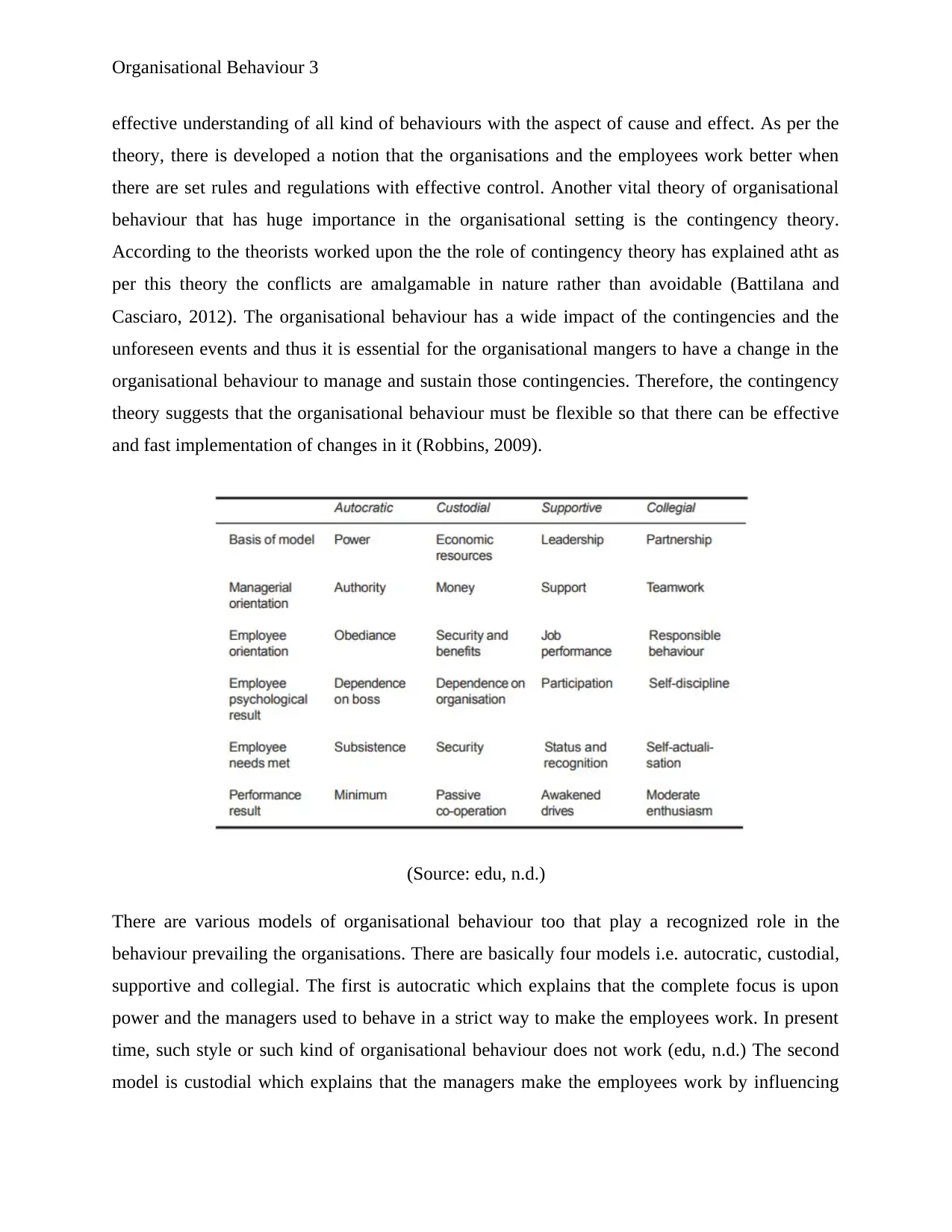
Organisational Behaviour 3
effective understanding of all kind of behaviours with the aspect of cause and effect. As per the
theory, there is developed a notion that the organisations and the employees work better when
there are set rules and regulations with effective control. Another vital theory of organisational
behaviour that has huge importance in the organisational setting is the contingency theory.
According to the theorists worked upon the the role of contingency theory has explained atht as
per this theory the conflicts are amalgamable in nature rather than avoidable (Battilana and
Casciaro, 2012). The organisational behaviour has a wide impact of the contingencies and the
unforeseen events and thus it is essential for the organisational mangers to have a change in the
organisational behaviour to manage and sustain those contingencies. Therefore, the contingency
theory suggests that the organisational behaviour must be flexible so that there can be effective
and fast implementation of changes in it (Robbins, 2009).
(Source: edu, n.d.)
There are various models of organisational behaviour too that play a recognized role in the
behaviour prevailing the organisations. There are basically four models i.e. autocratic, custodial,
supportive and collegial. The first is autocratic which explains that the complete focus is upon
power and the managers used to behave in a strict way to make the employees work. In present
time, such style or such kind of organisational behaviour does not work (edu, n.d.) The second
model is custodial which explains that the managers make the employees work by influencing
effective understanding of all kind of behaviours with the aspect of cause and effect. As per the
theory, there is developed a notion that the organisations and the employees work better when
there are set rules and regulations with effective control. Another vital theory of organisational
behaviour that has huge importance in the organisational setting is the contingency theory.
According to the theorists worked upon the the role of contingency theory has explained atht as
per this theory the conflicts are amalgamable in nature rather than avoidable (Battilana and
Casciaro, 2012). The organisational behaviour has a wide impact of the contingencies and the
unforeseen events and thus it is essential for the organisational mangers to have a change in the
organisational behaviour to manage and sustain those contingencies. Therefore, the contingency
theory suggests that the organisational behaviour must be flexible so that there can be effective
and fast implementation of changes in it (Robbins, 2009).
(Source: edu, n.d.)
There are various models of organisational behaviour too that play a recognized role in the
behaviour prevailing the organisations. There are basically four models i.e. autocratic, custodial,
supportive and collegial. The first is autocratic which explains that the complete focus is upon
power and the managers used to behave in a strict way to make the employees work. In present
time, such style or such kind of organisational behaviour does not work (edu, n.d.) The second
model is custodial which explains that the managers make the employees work by influencing
⊘ This is a preview!⊘
Do you want full access?
Subscribe today to unlock all pages.

Trusted by 1+ million students worldwide
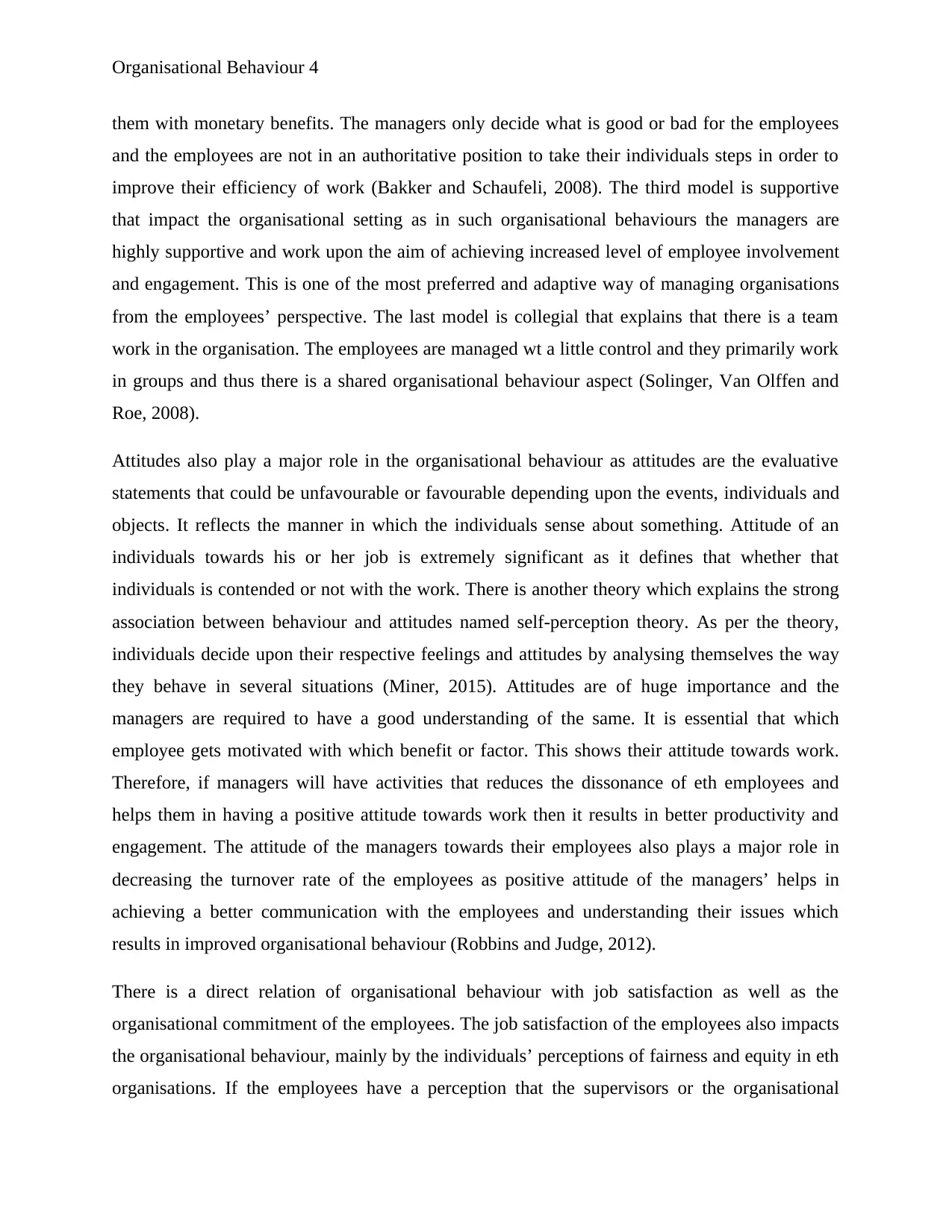
Organisational Behaviour 4
them with monetary benefits. The managers only decide what is good or bad for the employees
and the employees are not in an authoritative position to take their individuals steps in order to
improve their efficiency of work (Bakker and Schaufeli, 2008). The third model is supportive
that impact the organisational setting as in such organisational behaviours the managers are
highly supportive and work upon the aim of achieving increased level of employee involvement
and engagement. This is one of the most preferred and adaptive way of managing organisations
from the employees’ perspective. The last model is collegial that explains that there is a team
work in the organisation. The employees are managed wt a little control and they primarily work
in groups and thus there is a shared organisational behaviour aspect (Solinger, Van Olffen and
Roe, 2008).
Attitudes also play a major role in the organisational behaviour as attitudes are the evaluative
statements that could be unfavourable or favourable depending upon the events, individuals and
objects. It reflects the manner in which the individuals sense about something. Attitude of an
individuals towards his or her job is extremely significant as it defines that whether that
individuals is contended or not with the work. There is another theory which explains the strong
association between behaviour and attitudes named self-perception theory. As per the theory,
individuals decide upon their respective feelings and attitudes by analysing themselves the way
they behave in several situations (Miner, 2015). Attitudes are of huge importance and the
managers are required to have a good understanding of the same. It is essential that which
employee gets motivated with which benefit or factor. This shows their attitude towards work.
Therefore, if managers will have activities that reduces the dissonance of eth employees and
helps them in having a positive attitude towards work then it results in better productivity and
engagement. The attitude of the managers towards their employees also plays a major role in
decreasing the turnover rate of the employees as positive attitude of the managers’ helps in
achieving a better communication with the employees and understanding their issues which
results in improved organisational behaviour (Robbins and Judge, 2012).
There is a direct relation of organisational behaviour with job satisfaction as well as the
organisational commitment of the employees. The job satisfaction of the employees also impacts
the organisational behaviour, mainly by the individuals’ perceptions of fairness and equity in eth
organisations. If the employees have a perception that the supervisors or the organisational
them with monetary benefits. The managers only decide what is good or bad for the employees
and the employees are not in an authoritative position to take their individuals steps in order to
improve their efficiency of work (Bakker and Schaufeli, 2008). The third model is supportive
that impact the organisational setting as in such organisational behaviours the managers are
highly supportive and work upon the aim of achieving increased level of employee involvement
and engagement. This is one of the most preferred and adaptive way of managing organisations
from the employees’ perspective. The last model is collegial that explains that there is a team
work in the organisation. The employees are managed wt a little control and they primarily work
in groups and thus there is a shared organisational behaviour aspect (Solinger, Van Olffen and
Roe, 2008).
Attitudes also play a major role in the organisational behaviour as attitudes are the evaluative
statements that could be unfavourable or favourable depending upon the events, individuals and
objects. It reflects the manner in which the individuals sense about something. Attitude of an
individuals towards his or her job is extremely significant as it defines that whether that
individuals is contended or not with the work. There is another theory which explains the strong
association between behaviour and attitudes named self-perception theory. As per the theory,
individuals decide upon their respective feelings and attitudes by analysing themselves the way
they behave in several situations (Miner, 2015). Attitudes are of huge importance and the
managers are required to have a good understanding of the same. It is essential that which
employee gets motivated with which benefit or factor. This shows their attitude towards work.
Therefore, if managers will have activities that reduces the dissonance of eth employees and
helps them in having a positive attitude towards work then it results in better productivity and
engagement. The attitude of the managers towards their employees also plays a major role in
decreasing the turnover rate of the employees as positive attitude of the managers’ helps in
achieving a better communication with the employees and understanding their issues which
results in improved organisational behaviour (Robbins and Judge, 2012).
There is a direct relation of organisational behaviour with job satisfaction as well as the
organisational commitment of the employees. The job satisfaction of the employees also impacts
the organisational behaviour, mainly by the individuals’ perceptions of fairness and equity in eth
organisations. If the employees have a perception that the supervisors or the organisational
Paraphrase This Document
Need a fresh take? Get an instant paraphrase of this document with our AI Paraphraser
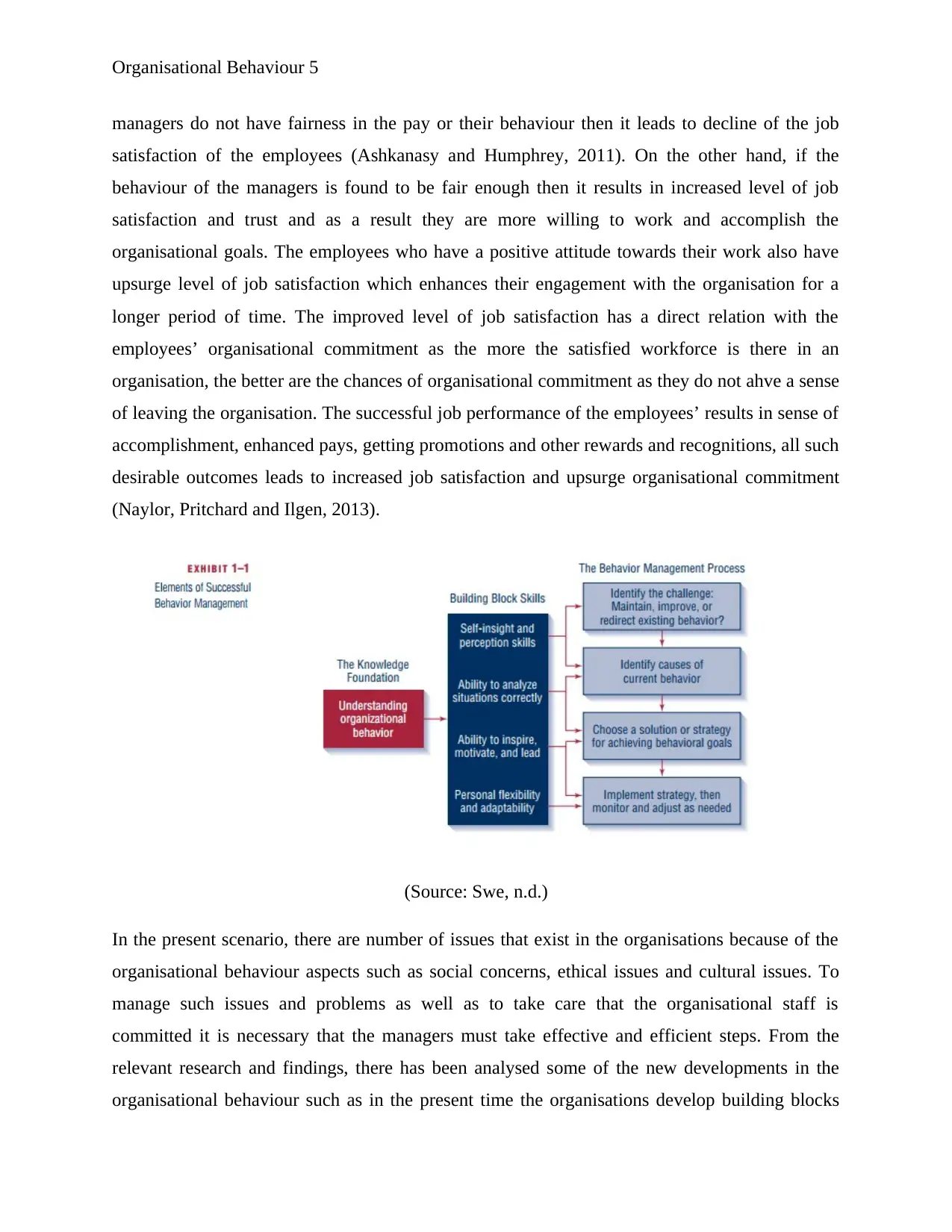
Organisational Behaviour 5
managers do not have fairness in the pay or their behaviour then it leads to decline of the job
satisfaction of the employees (Ashkanasy and Humphrey, 2011). On the other hand, if the
behaviour of the managers is found to be fair enough then it results in increased level of job
satisfaction and trust and as a result they are more willing to work and accomplish the
organisational goals. The employees who have a positive attitude towards their work also have
upsurge level of job satisfaction which enhances their engagement with the organisation for a
longer period of time. The improved level of job satisfaction has a direct relation with the
employees’ organisational commitment as the more the satisfied workforce is there in an
organisation, the better are the chances of organisational commitment as they do not ahve a sense
of leaving the organisation. The successful job performance of the employees’ results in sense of
accomplishment, enhanced pays, getting promotions and other rewards and recognitions, all such
desirable outcomes leads to increased job satisfaction and upsurge organisational commitment
(Naylor, Pritchard and Ilgen, 2013).
(Source: Swe, n.d.)
In the present scenario, there are number of issues that exist in the organisations because of the
organisational behaviour aspects such as social concerns, ethical issues and cultural issues. To
manage such issues and problems as well as to take care that the organisational staff is
committed it is necessary that the managers must take effective and efficient steps. From the
relevant research and findings, there has been analysed some of the new developments in the
organisational behaviour such as in the present time the organisations develop building blocks
managers do not have fairness in the pay or their behaviour then it leads to decline of the job
satisfaction of the employees (Ashkanasy and Humphrey, 2011). On the other hand, if the
behaviour of the managers is found to be fair enough then it results in increased level of job
satisfaction and trust and as a result they are more willing to work and accomplish the
organisational goals. The employees who have a positive attitude towards their work also have
upsurge level of job satisfaction which enhances their engagement with the organisation for a
longer period of time. The improved level of job satisfaction has a direct relation with the
employees’ organisational commitment as the more the satisfied workforce is there in an
organisation, the better are the chances of organisational commitment as they do not ahve a sense
of leaving the organisation. The successful job performance of the employees’ results in sense of
accomplishment, enhanced pays, getting promotions and other rewards and recognitions, all such
desirable outcomes leads to increased job satisfaction and upsurge organisational commitment
(Naylor, Pritchard and Ilgen, 2013).
(Source: Swe, n.d.)
In the present scenario, there are number of issues that exist in the organisations because of the
organisational behaviour aspects such as social concerns, ethical issues and cultural issues. To
manage such issues and problems as well as to take care that the organisational staff is
committed it is necessary that the managers must take effective and efficient steps. From the
relevant research and findings, there has been analysed some of the new developments in the
organisational behaviour such as in the present time the organisations develop building blocks
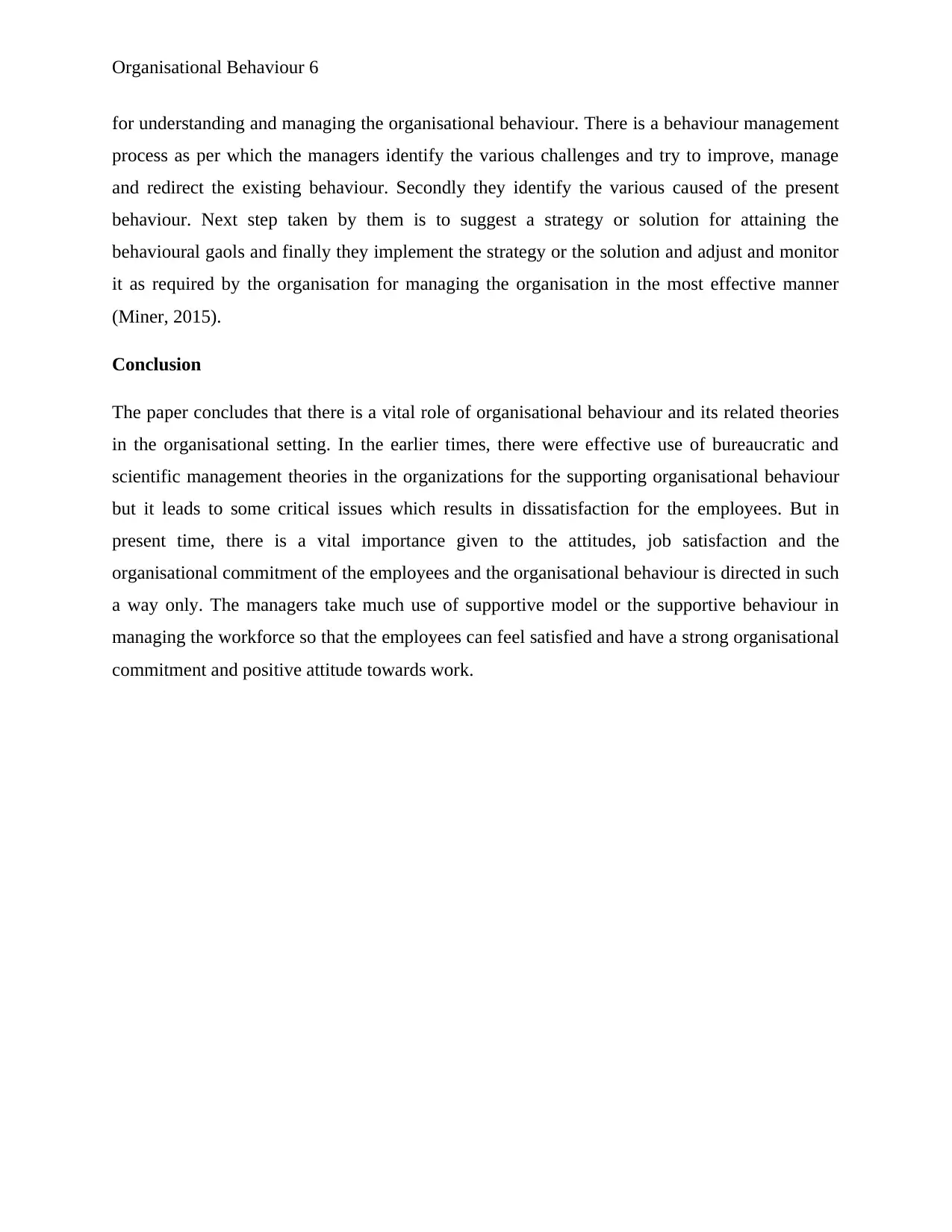
Organisational Behaviour 6
for understanding and managing the organisational behaviour. There is a behaviour management
process as per which the managers identify the various challenges and try to improve, manage
and redirect the existing behaviour. Secondly they identify the various caused of the present
behaviour. Next step taken by them is to suggest a strategy or solution for attaining the
behavioural gaols and finally they implement the strategy or the solution and adjust and monitor
it as required by the organisation for managing the organisation in the most effective manner
(Miner, 2015).
Conclusion
The paper concludes that there is a vital role of organisational behaviour and its related theories
in the organisational setting. In the earlier times, there were effective use of bureaucratic and
scientific management theories in the organizations for the supporting organisational behaviour
but it leads to some critical issues which results in dissatisfaction for the employees. But in
present time, there is a vital importance given to the attitudes, job satisfaction and the
organisational commitment of the employees and the organisational behaviour is directed in such
a way only. The managers take much use of supportive model or the supportive behaviour in
managing the workforce so that the employees can feel satisfied and have a strong organisational
commitment and positive attitude towards work.
for understanding and managing the organisational behaviour. There is a behaviour management
process as per which the managers identify the various challenges and try to improve, manage
and redirect the existing behaviour. Secondly they identify the various caused of the present
behaviour. Next step taken by them is to suggest a strategy or solution for attaining the
behavioural gaols and finally they implement the strategy or the solution and adjust and monitor
it as required by the organisation for managing the organisation in the most effective manner
(Miner, 2015).
Conclusion
The paper concludes that there is a vital role of organisational behaviour and its related theories
in the organisational setting. In the earlier times, there were effective use of bureaucratic and
scientific management theories in the organizations for the supporting organisational behaviour
but it leads to some critical issues which results in dissatisfaction for the employees. But in
present time, there is a vital importance given to the attitudes, job satisfaction and the
organisational commitment of the employees and the organisational behaviour is directed in such
a way only. The managers take much use of supportive model or the supportive behaviour in
managing the workforce so that the employees can feel satisfied and have a strong organisational
commitment and positive attitude towards work.
⊘ This is a preview!⊘
Do you want full access?
Subscribe today to unlock all pages.

Trusted by 1+ million students worldwide
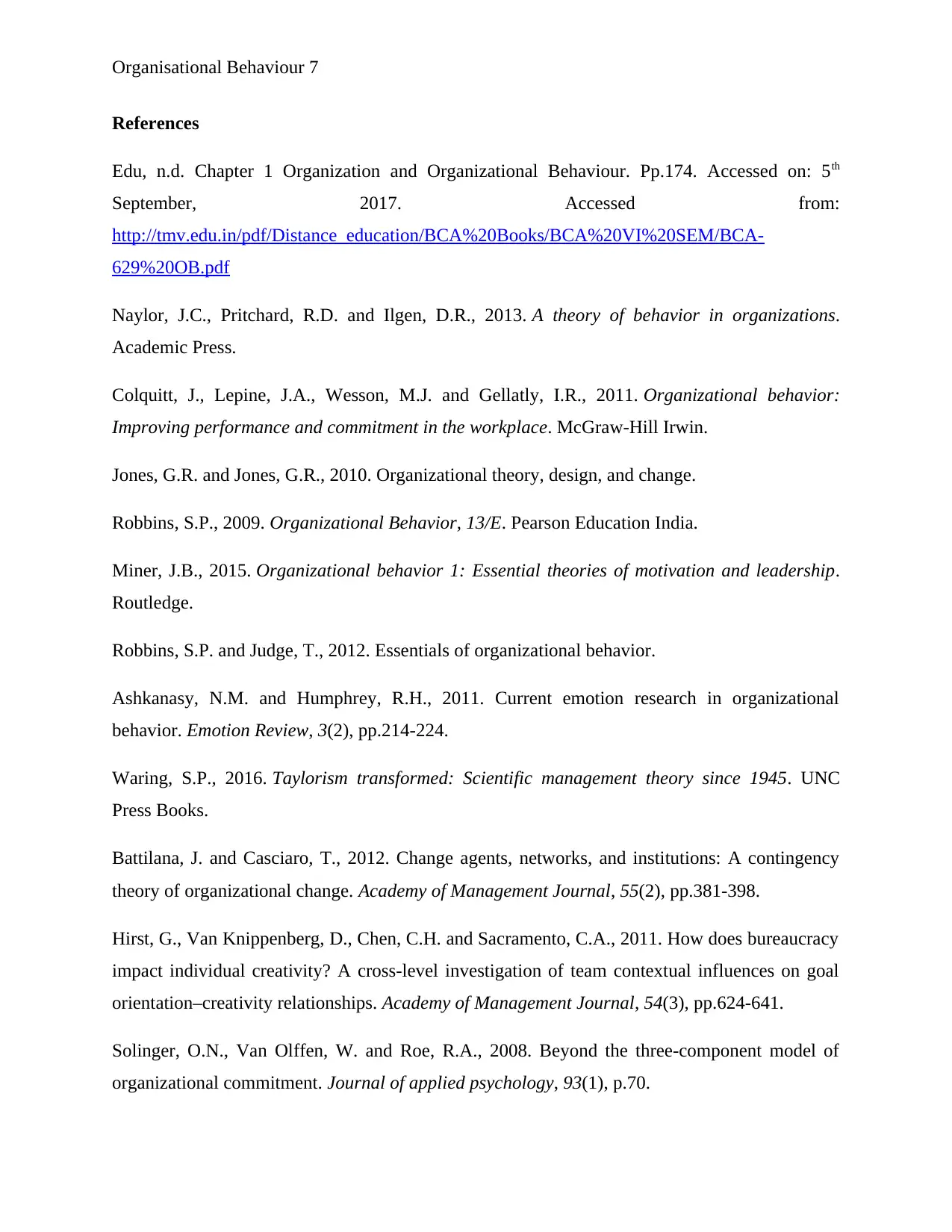
Organisational Behaviour 7
References
Edu, n.d. Chapter 1 Organization and Organizational Behaviour. Pp.174. Accessed on: 5th
September, 2017. Accessed from:
http://tmv.edu.in/pdf/Distance_education/BCA%20Books/BCA%20VI%20SEM/BCA-
629%20OB.pdf
Naylor, J.C., Pritchard, R.D. and Ilgen, D.R., 2013. A theory of behavior in organizations.
Academic Press.
Colquitt, J., Lepine, J.A., Wesson, M.J. and Gellatly, I.R., 2011. Organizational behavior:
Improving performance and commitment in the workplace. McGraw-Hill Irwin.
Jones, G.R. and Jones, G.R., 2010. Organizational theory, design, and change.
Robbins, S.P., 2009. Organizational Behavior, 13/E. Pearson Education India.
Miner, J.B., 2015. Organizational behavior 1: Essential theories of motivation and leadership.
Routledge.
Robbins, S.P. and Judge, T., 2012. Essentials of organizational behavior.
Ashkanasy, N.M. and Humphrey, R.H., 2011. Current emotion research in organizational
behavior. Emotion Review, 3(2), pp.214-224.
Waring, S.P., 2016. Taylorism transformed: Scientific management theory since 1945. UNC
Press Books.
Battilana, J. and Casciaro, T., 2012. Change agents, networks, and institutions: A contingency
theory of organizational change. Academy of Management Journal, 55(2), pp.381-398.
Hirst, G., Van Knippenberg, D., Chen, C.H. and Sacramento, C.A., 2011. How does bureaucracy
impact individual creativity? A cross-level investigation of team contextual influences on goal
orientation–creativity relationships. Academy of Management Journal, 54(3), pp.624-641.
Solinger, O.N., Van Olffen, W. and Roe, R.A., 2008. Beyond the three-component model of
organizational commitment. Journal of applied psychology, 93(1), p.70.
References
Edu, n.d. Chapter 1 Organization and Organizational Behaviour. Pp.174. Accessed on: 5th
September, 2017. Accessed from:
http://tmv.edu.in/pdf/Distance_education/BCA%20Books/BCA%20VI%20SEM/BCA-
629%20OB.pdf
Naylor, J.C., Pritchard, R.D. and Ilgen, D.R., 2013. A theory of behavior in organizations.
Academic Press.
Colquitt, J., Lepine, J.A., Wesson, M.J. and Gellatly, I.R., 2011. Organizational behavior:
Improving performance and commitment in the workplace. McGraw-Hill Irwin.
Jones, G.R. and Jones, G.R., 2010. Organizational theory, design, and change.
Robbins, S.P., 2009. Organizational Behavior, 13/E. Pearson Education India.
Miner, J.B., 2015. Organizational behavior 1: Essential theories of motivation and leadership.
Routledge.
Robbins, S.P. and Judge, T., 2012. Essentials of organizational behavior.
Ashkanasy, N.M. and Humphrey, R.H., 2011. Current emotion research in organizational
behavior. Emotion Review, 3(2), pp.214-224.
Waring, S.P., 2016. Taylorism transformed: Scientific management theory since 1945. UNC
Press Books.
Battilana, J. and Casciaro, T., 2012. Change agents, networks, and institutions: A contingency
theory of organizational change. Academy of Management Journal, 55(2), pp.381-398.
Hirst, G., Van Knippenberg, D., Chen, C.H. and Sacramento, C.A., 2011. How does bureaucracy
impact individual creativity? A cross-level investigation of team contextual influences on goal
orientation–creativity relationships. Academy of Management Journal, 54(3), pp.624-641.
Solinger, O.N., Van Olffen, W. and Roe, R.A., 2008. Beyond the three-component model of
organizational commitment. Journal of applied psychology, 93(1), p.70.
Paraphrase This Document
Need a fresh take? Get an instant paraphrase of this document with our AI Paraphraser
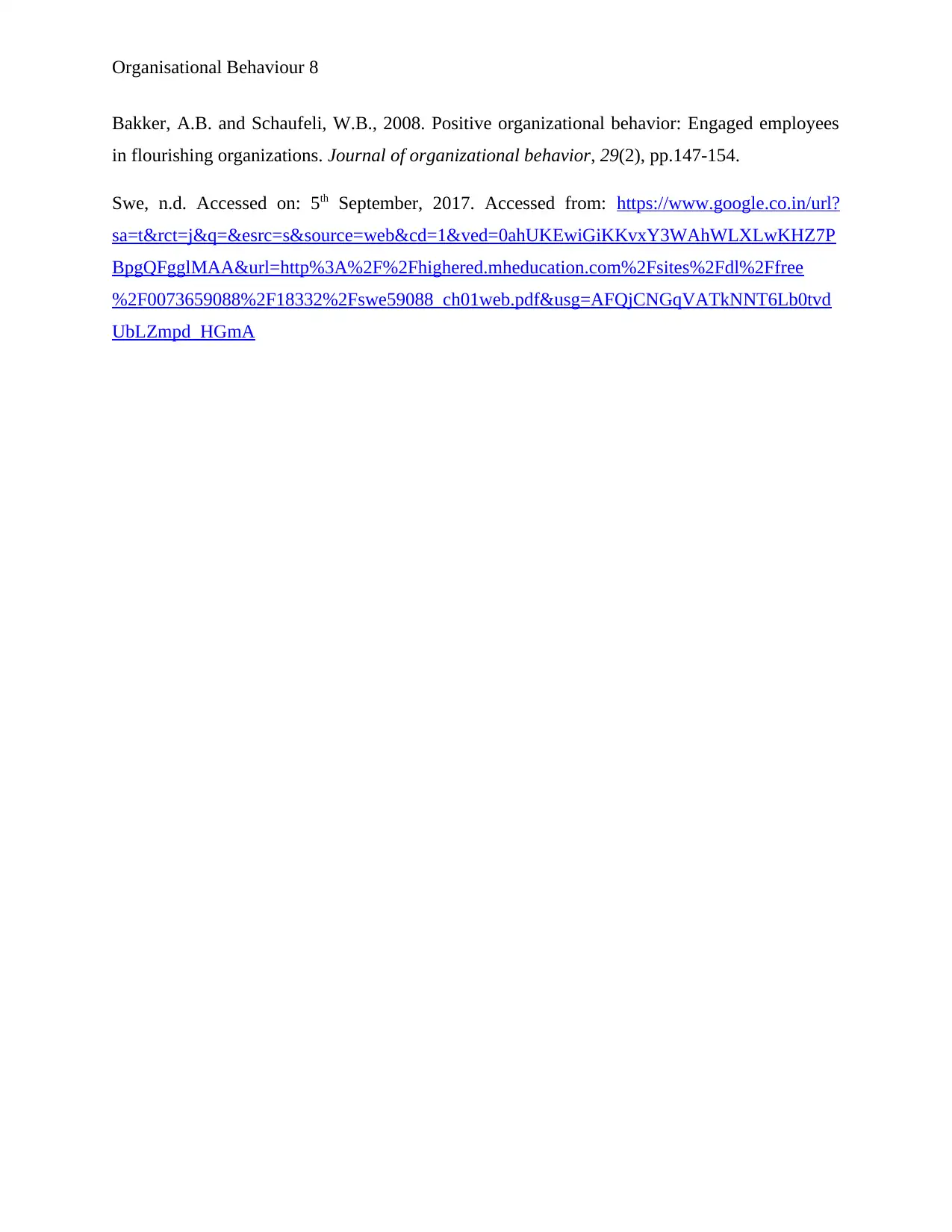
Organisational Behaviour 8
Bakker, A.B. and Schaufeli, W.B., 2008. Positive organizational behavior: Engaged employees
in flourishing organizations. Journal of organizational behavior, 29(2), pp.147-154.
Swe, n.d. Accessed on: 5th September, 2017. Accessed from: https://www.google.co.in/url?
sa=t&rct=j&q=&esrc=s&source=web&cd=1&ved=0ahUKEwiGiKKvxY3WAhWLXLwKHZ7P
BpgQFgglMAA&url=http%3A%2F%2Fhighered.mheducation.com%2Fsites%2Fdl%2Ffree
%2F0073659088%2F18332%2Fswe59088_ch01web.pdf&usg=AFQjCNGqVATkNNT6Lb0tvd
UbLZmpd_HGmA
Bakker, A.B. and Schaufeli, W.B., 2008. Positive organizational behavior: Engaged employees
in flourishing organizations. Journal of organizational behavior, 29(2), pp.147-154.
Swe, n.d. Accessed on: 5th September, 2017. Accessed from: https://www.google.co.in/url?
sa=t&rct=j&q=&esrc=s&source=web&cd=1&ved=0ahUKEwiGiKKvxY3WAhWLXLwKHZ7P
BpgQFgglMAA&url=http%3A%2F%2Fhighered.mheducation.com%2Fsites%2Fdl%2Ffree
%2F0073659088%2F18332%2Fswe59088_ch01web.pdf&usg=AFQjCNGqVATkNNT6Lb0tvd
UbLZmpd_HGmA
1 out of 8
Related Documents
Your All-in-One AI-Powered Toolkit for Academic Success.
+13062052269
info@desklib.com
Available 24*7 on WhatsApp / Email
![[object Object]](/_next/static/media/star-bottom.7253800d.svg)
Unlock your academic potential
Copyright © 2020–2025 A2Z Services. All Rights Reserved. Developed and managed by ZUCOL.





